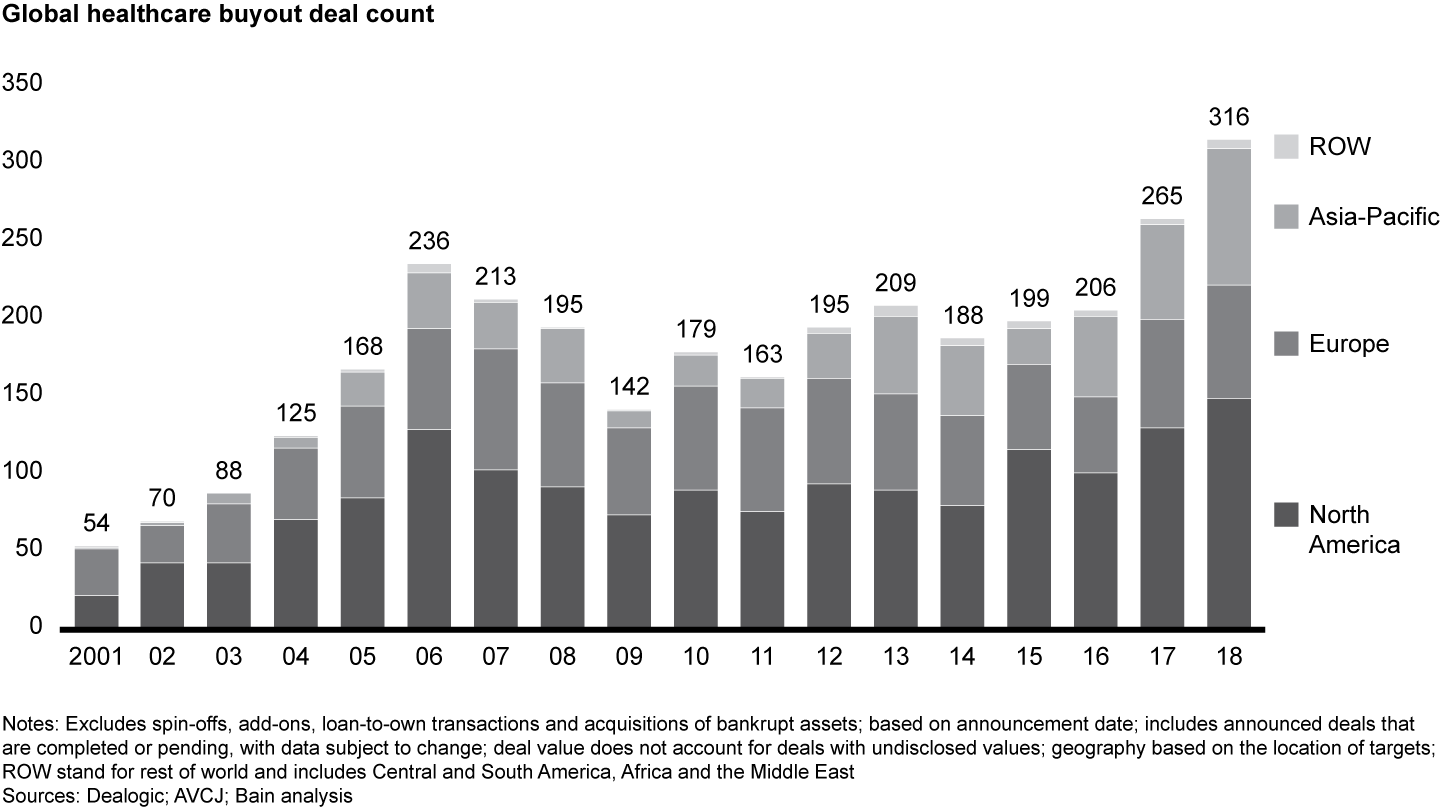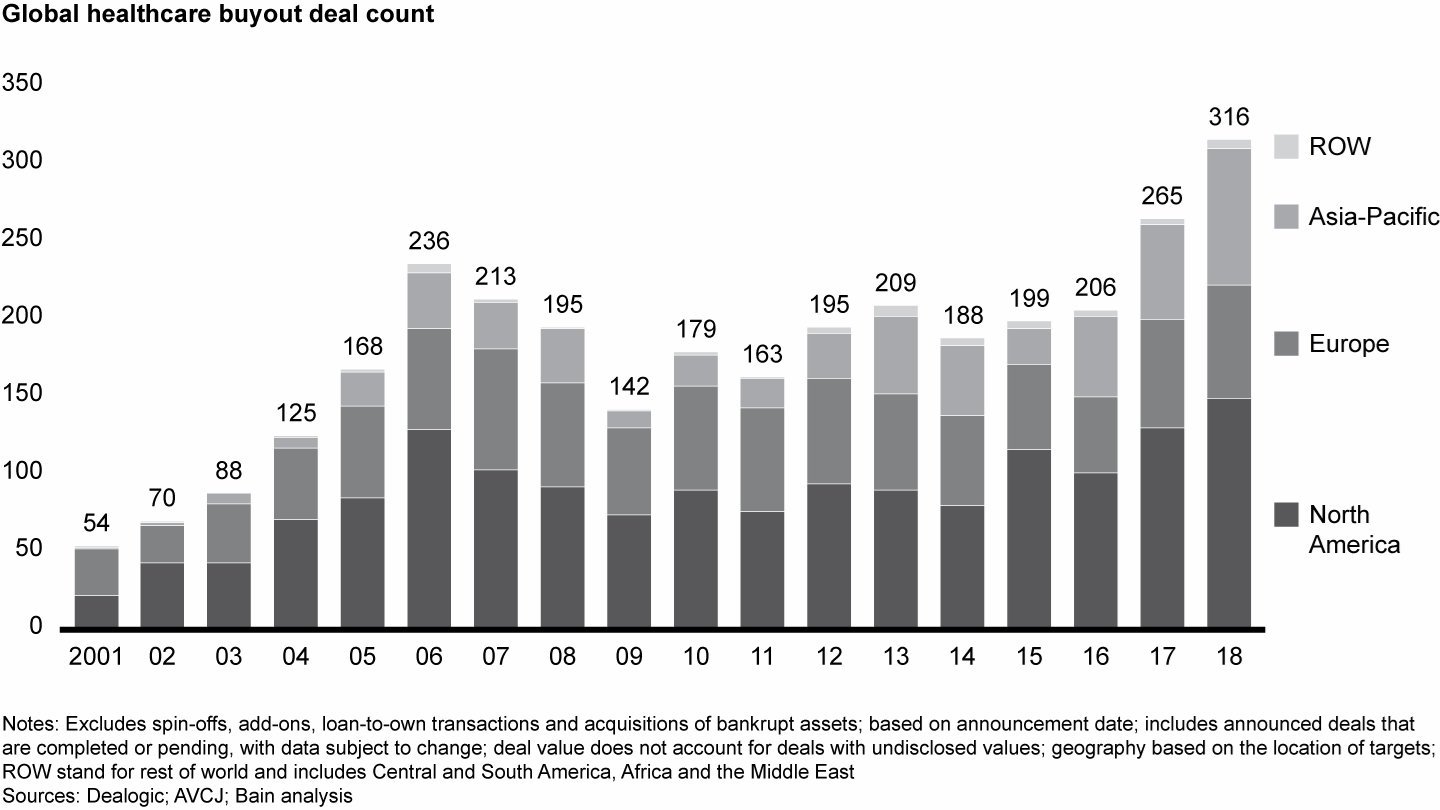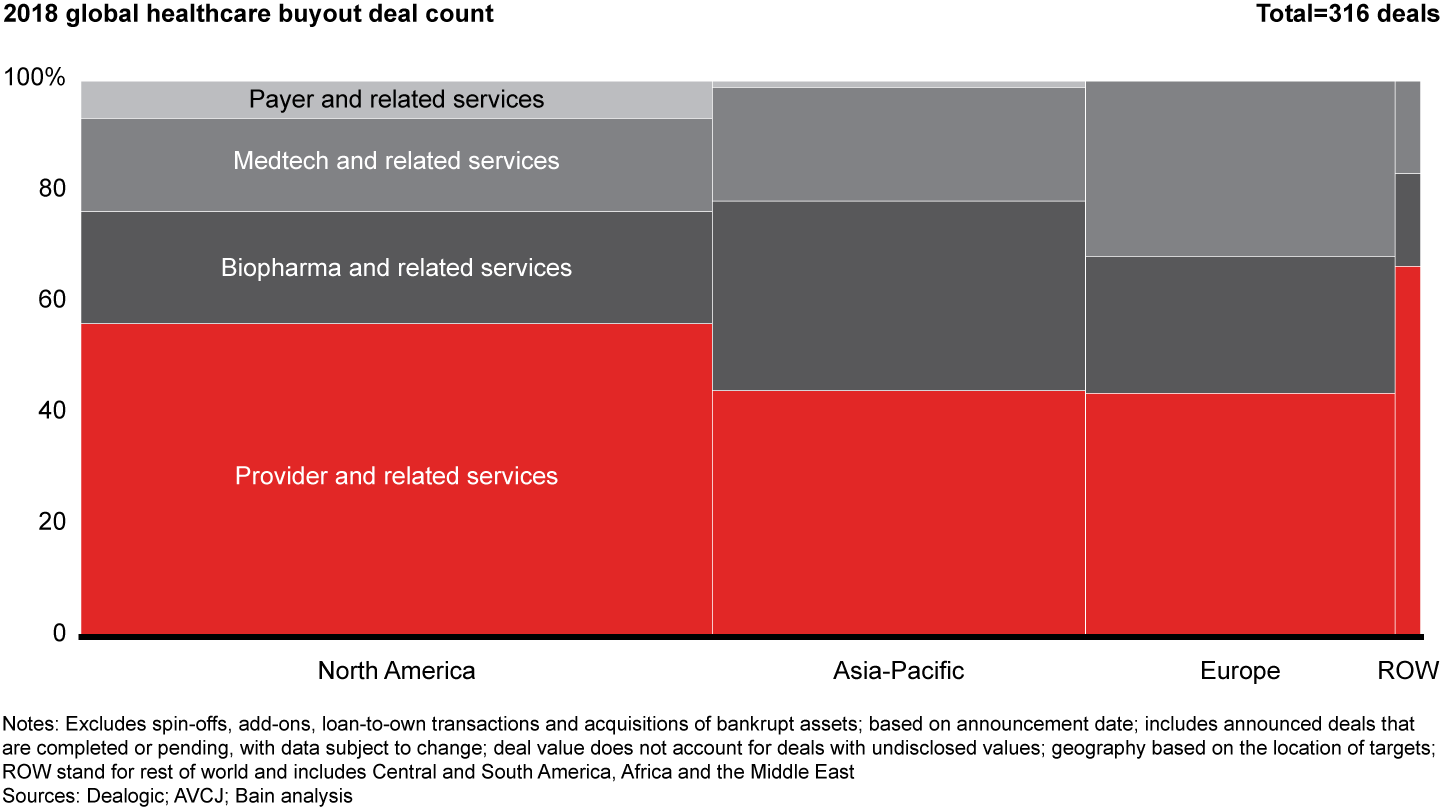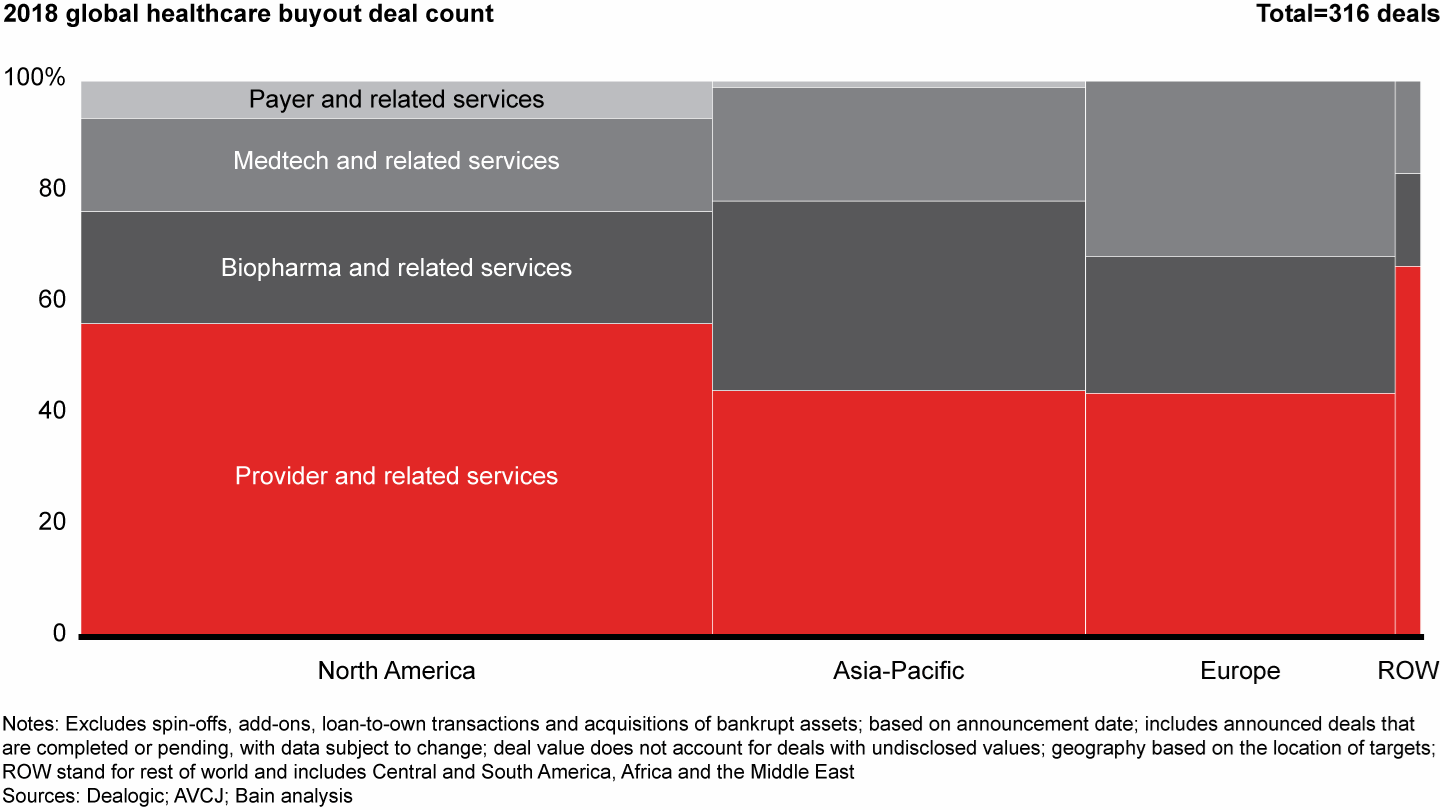Report

In evidenza
- Deals surged to a record 149 in 2018, with a total disclosed value of $29.6 billion, led by large public-to-private transactions, more clarity on regulatory changes and continued buy-and-build activity in the provider sector.
- Provider deals continued to account for most of the volume and value, at 84 deals worth $23.2 billion, or 37% of the global healthcare total. Behavioral health, retail health, PPM and home care drew strong interest.
- Two large deals were notable: KKR acquired Envision Healthcare for $9.9 billion, and athenahealth went to a consortium that included Veritas Capital and Elliott Management’s Evergreen Coast Capital for $5.7 billion.
This article is part of Bain’s 2019 Global Healthcare Private Equity and Corporate M&A Report. Explore the contents of the report here or download the PDF to read the full report.
-
Click to Expand: Regional Overview
Global healthcare PE activity set another record in 2018, with 316 announced deals valued at $63.1 billion—a marked increase over $42.6 billion across 265 deals in 2017. Activity and disclosed value rose in every region, an increase that was especially pronounced in Asia-Pacific, where the volume of announced deals grew by 44%.
The rise in values stemmed primarily from more large buyouts, as eight deals in 2018 were valued at greater than $2 billion each vs. just four in 2017. Across regions, the provider sector again was the most active, accounting for more than half of total deal activity and disclosed value. Biopharma posted the second-largest share, accounting for roughly one-quarter of volume and value globally.
Similar to prior years, the countries outside North America, Europe and the Asia-Pacific region saw minimal healthcare PE deal activity in 2018. There were six buyouts, two more than 2017, with no deal values disclosed. Of those six buyouts, four occurred in the provider sector, and three of those had Brazilian targets. This was a departure from 2016 and 2017 activity, which each saw just one deal in the provider sector and one Brazilian target.
The US remained the world’s largest healthcare investing market, with widespread activity across sectors. In 2018, North America once again accounted for the most deals, 149, and highest announced deal value, $29.6 billion—both higher than 2017 levels (see Figures 5 and 6).
North America and Asia-Pacific saw increased deal activity, while Europe was relatively flat


The provider sector was the most active across all geographies


Long-term trends, such as an aging population, the rising prevalence of chronic disease, and expanding demand for quality and efficiency, have propelled North American healthcare investment activity for several years. Investors maintained strong interest in North American healthcare assets throughout 2018 for two other reasons as well: First, investors view healthcare assets as somewhat insulated from downward market trends that could be on the horizon; second, funds became more confident in underwriting deal values as they gained clarity on potential US regulatory changes, including the Affordable Care Act.
As a result, North American healthcare buyout activity set a record-level deal count of 149 on total disclosed value of $29.6 billion in 2018, up from 130 and $22.1 billion in 2017. Assets continue to be in high demand, with an expanding range of lower middle-market to large-cap funds chasing deals. As the disclosed value of overall North American private equity surged 35% in 2018, healthcare kept pace, comprising 14% of total North American disclosed deal value in each of the past two years.
Consistent with the prior decade, deals involving providers continued to lead the way, as more consumer-friendly, alternative care delivery models gain favor and the market shifts away from acute care settings. Investors thus have been looking for ways to build scale in fragmented categories and geographies. The most successful investment theses typically join a buy-and-build strategy with a commitment to deliver care to patients more effectively.
The provider sector accounted for 84 deals worth $23.2 billion of disclosed value, including the region’s three largest deals of the year. Investors continued their sharp focus from prior years on PPM assets. Within the PPM segment, KKR executed a $9.9 billion take-private acquisition of Envision Healthcare in the biggest deal of the year globally, and a Summit Partners–led group partnered with OptumHealth to acquire a controlling stake in Sound Inpatient Physicians for $2.2 billion.
Taking on reimbursement risk did not deter many investors, as more than one-third of North American deals were for healthcare-heavy assets. Over time, investors have become more comfortable underwriting reimbursement risk as they become more experienced and the deal environment remains highly competitive. For example, firms have become more adept at understanding and underwriting out-of-network risks associated with PPMs, investing in spaces with heavier exposure to Medicare and Medicaid reimbursement, such as home health, hospice, behavioral health and durable medical equipment. Funds have also taken on capitated payment risks through acquisitions in companies such as naviHealth and Landmark Health (see “Provider and related services: Intense competition and a push into new segments”).
Within the provider segment, we saw strong interest in retail health assets, even as deal values rose after several years of consolidation, resulting in more mature platforms. In addition to nationally scaled platforms, such as Oak Hill Capital Partners’ stake investment in VetCor Professional Practices, funds pursued regional deals as well, including Lindsay Goldberg’s acquisition of PT Solutions, a physical therapy services platform with more than 140 locations mostly concentrated across the southeastern US. Funds also launched new platforms in 2018 with hopes of eventually developing the scale of these more mature platforms. Waud Capital committed $100 million to develop an integrated veterinary services platform named Heart + Paw.
Behavioral health attracted more investor interest in 2018. Many behavioral specialties are experiencing a shortage of providers and are highly fragmented across diverse therapeutic areas and physicians, thus offering opportunities to execute buy-and-build strategies in a new segment. Investors looked in particular to autism-focused providers as a rapidly growing market with a clear clinical impact that is ripe for building platforms. For example, Blackstone acquired CARD for an undisclosed value, and KKR launched its Blue Sprig autism behavioral health platform (see “Provider and related services: Intense competition and a push into new segments”).
Home care and hospice were equally hot in 2018. These large, fragmented segments benefit from strong underlying macro trends and now have a more settled regulatory environment after the Centers for Medicare and Medicaid Services withdrew plans for reimbursement changes in mid-2017. TPG and Welsh, Carson, Anderson & Stowe’s partnership with Humana to acquire Curo Health Services for $1.4 billion was the most prominent home health and hospice deal of the year, and it comes on the heels of the consortium’s 2017 acquisition of Kindred. Kelso & Company and Blue Wolf Capital also teamed up to acquire Jordan Health Services, which they will combine with Blue Wolf’s other home care portfolio companies.
Provider-focused HCIT investments continued to garner attention as well. Solutions such as electronic medical records (EMR) and RCM have matured, leading to large deals such as Veritas Capital and Evergreen Coast Capital’s acquisition of athenahealth for $5.7 billion. Similarly, Bain Capital added to its Waystar platform with the add-on acquisition of Connance. With steep prices for large, mature assets, we expect investors to focus more on niche category leaders in the near future.
Turning to biopharma, deal count rose to 30 in 2018, up from 20 in 2017, as several large funds increased their presence in this segment and even started taking on clinical risk. For example, Bain Capital purchased development-stage neuroscience assets from Pfizer for $350 million, carving them out as a new entity renamed Cerevel. Some large funds, including Bain Capital and Blackstone, have even developed investment vehicles in recent years to pursue biopharma assets with clinical risk.
Medtech assets drew interest in fields ranging from single-use patient products to durable medical equipment. Investors could pick up some previously public assets at attractive valuations as some medtech companies have been selling noncore assets. For example, Platinum Equity acquired Johnson & Johnson’s LifeScan, which develops blood glucose–monitoring systems, for $2.1 billion. Investors also showed growing interest in consumer-focused medtech, as evidenced by a $380 million minority investment in SmileDirectClub by a CD&R-led consortium.
Strong competition for quality assets led investors to employ creative deal strategies. Funds have teamed up with other financial sponsors or corporate partners in order to reach the high purchase prices; 4 of the top 10 deals in North America included financial sponsor consortiums or corporate partnering. Investors also had to look outside of traditional buyout markets, so three of the top six deals in the region were public-to-private transactions. And activist investors played a role in motivating public companies to go private or spin out noncore assets. For example, Elliott Management helped spur athenahealth’s sale to Veritas Capital and Evergreen Coast Capital.
We expect heightened interest in the region’s healthcare market in 2019. For one thing, North American healthcare assets acquired during a recession tend to outperform investments made in most other sectors. According to CEPRES, a digital investment platform and transactional network for the private capital markets, healthcare PE investments made from 2006 through 2008 returned nearly a full additional turn on invested capital vs. nonhealthcare PE investments during the same period (see “2019 and beyond: Uncertainty in many markets, but healthcare private equity may be an oasis of relative calm”).
More capital than ever is chasing North American healthcare assets, following robust fund-raising efforts and increased interest from major buyout firms with healthcare investing track records, such as Welsh, Carson, Anderson & Stowe; Cressey & Company; and Waud Capital. Firms new to healthcare are also entering the market, such as Sun Capital, which acquired ClearChoice dental implant services in 2017.
In this competitive environment, we expect funds to explore more opportunities in public markets and to join with corporate partners more often in a bid to diversify their portfolios and gain a strategic edge. And we expect established investors to double down on their existing portfolios through thoughtful add-on acquisitions.